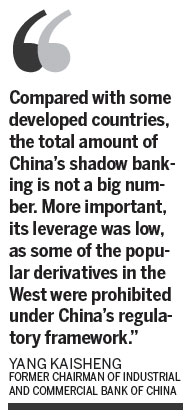Shadow banking offers no cause for alarm: Experts
Leverage in sector remains low due to China's limitations on derivatives
China's banking sector remains solid, with the shadow banking sector well under control, Yang Kaisheng, former chairman of Industrial and Commercial Bank of China, the country's largest lender, said on Thursday.
By the end of 2012, China's shadow banking sector accounted for about 10 percent of GDP, while the figure in the US was 150 percent, according to Yang, a CPPCC member.
"Compared with some developed countries, the total amount of China's shadow banking is not a big number. More important, its leverage was low, as some of the popular derivatives in the West were prohibited under China's regulatory framework," said Yang.
Shadow banking is a term for the collection of non-bank financial intermediaries that provide services similar to traditional commercial banks.
The recent default crisis that affected several Chinese trust companies triggered concerns about the country's shadow banking, and some economists worried that it could lead to a possible financial meltdown.

In the latest case, Jilin Province Trust, which raised 1 billion yuan ($162.5 million) to invest in a private coal miner in north China's Shanxi province, told its clients that it had no repayment timetable as the debtor itself was mired in debt.
The trust company missed payments for five tranches. The sixth is due to mature March 11. That followed a similar product default by China Credit Trust Co in January.
According to Standard & Poor's, the rating agency has grown increasing concerns about the fast-growing types of shadow banking credit-non-bank-issued wealth management products .
These are issued by an array of non-bank actors such as local government financing vehicles, property developers and trust companies. The underlying assets can essentially be anything. The promised returns on these products (at around 10 percent) tend to be double those issued by the banks themselves, making them very attractive to investors.
And, critically, these products are sold through the (implicitly State-guaranteed) banks, just like the banks' own WMPs.
Certain components of the shadow-banking sector, notably trust companies, may prove to be the weak link in China's financial sector, according to Standard & Poor's.
"However, we expect the credit profiles of major banks that we rate to remain adequate this year," said Liao Qiang, an analyst with Standard & Poor's.
"In our view, the government's pragmatic approach to addressing shadow banking risks and fine-tuned policies toward refinancing of local government debt could temper any risk of severe credit losses," Liao said.
Yang also said the liquidity in China's banking sector remains healthy, based on several key indicators in the regulatory framework.
The real liquidity ratio, for instance, is close to 44 percent, much higher than the industry watchdog's requirement of 25 percent. And the loan-to-deposit ratio is 65.4 percent, lower than the ceiling of 75 percent required by the regulator, according to Yang.
|
Yang Kaisheng, CPPCC member and former chairman of the Industrial and Commercial Bank of China, answers questions at a news conference on Thursday afternoon. Zou Hong / China Daily |
(China Daily 03/07/2014 page17)















